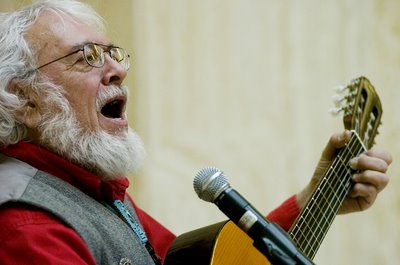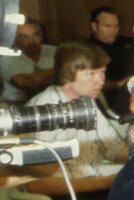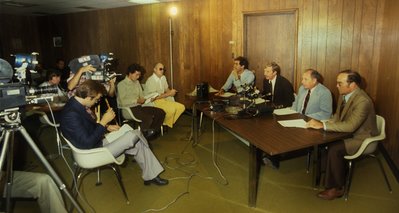I visited the State legislature a couple of weeks ago and wandered into a phenomenon that helps put definition to the slogan that the City of Santa Fe uses; the city different. I walked into the rotunda of the state capitol.
In the building dubbed “the merry roundhouse,” by the late radio newsman/commentator Ernie Mills, one might want to say that, with what can sometimes only be described as legislative antics of the House and Senate, there is a third ring; the rotunda.
It is the public square, albeit round. Groups wanting to display their influence are granted use of the room to show support or to protest their interests during the session.
The activities are often coordinated and accompanied with speeches, drama, song, and dance. Sometimes there are delicious refreshments served. At other times, you’re lucky to get a stale cookie.
 This is former Lt. Gov. Roberto Mondragon in the rotunda on “Native American day,” as he spoke about the importance of water to New Mexicans, then played a guitar and sang for the assembled crowd.
This is former Lt. Gov. Roberto Mondragon in the rotunda on “Native American day,” as he spoke about the importance of water to New Mexicans, then played a guitar and sang for the assembled crowd.Mondragon served as State Representative from Bernalillo County from 1967 to 1970, then with Gov. Bruce King from 1971–1974 and again from 1979–1982.
Mondragon ran in the Democratic primary for U.S. Senate in 1972, as Democratic candidate for U.S. House of Representative in 1974 in the original 1st District, before there was a third district, representing the northern part of the state, losing to incumbent Manuel Lujan Jr. He then ran again in 1982 in the Democratic primary for U.S. House of Representative in the 3rd District, which was then held by current Gov. Bill Richardson.
Mondragon also ran for governor in 1994 and also ran for state representative from Santa Fe County in 1996 as a green party candidate, getting just over 10 percent of the vote.
Mondragon currently serves as Special Water Projects Coordinator in the Office of the State Engineer and Interstate Stream Commission. He specializes in acequia programs, and other water projects
According to a State Engineer’s press release announcing Mondragon’s hiring last year, he had also served as Director of the New Mexico Commission on Aging from 1975 to 1978, and was Director of the State Housing Authority in 1983.
Mondragon is a living cultural icon, a walking font of historic knowledge. He has worked with non-profit and profit-based organizations spreading New Mexico’s culture through bilingual programs. He is also an accomplished musician and uses song to impart his message.
So what's wrong with this picture?
 This is election night 1970, when Mondragon learned that the local television stations had just projected that he and King had been elected. He looks like a kid; he probably was.
This is election night 1970, when Mondragon learned that the local television stations had just projected that he and King had been elected. He looks like a kid; he probably was.  This is Russell Means of San Jose, N.M. This was the first time I photographed Means, though I have followed his politics back to the early 1970s, when he was a prominent leader of the American Indian Movement. AIM was known for several high-profile acts of civil disobedience, taking over public places including, Mount Rushmore, S.D. in 1970, Wounded Knee on the Pine Ridge Indian Reservation, S.D. in 1973, and the Bureau of Indian Affairs offices in Washington, D.C. in 1973.
This is Russell Means of San Jose, N.M. This was the first time I photographed Means, though I have followed his politics back to the early 1970s, when he was a prominent leader of the American Indian Movement. AIM was known for several high-profile acts of civil disobedience, taking over public places including, Mount Rushmore, S.D. in 1970, Wounded Knee on the Pine Ridge Indian Reservation, S.D. in 1973, and the Bureau of Indian Affairs offices in Washington, D.C. in 1973.Means has a more mainstream political history, having formally run for the presidency of the Oglala Sioux tribe in 1974. He was defeated, but due to massive voter fraud, a federal court ordered a new election. The fraudulent government refused, and the court did not enforce its ruling.
Means unsuccessfully sought the presidential nomination of the Libertarian Party in 1987. In 2002, he ran for New Mexico governor as an independent, but the Secretary of State claimed he appeared 10-minutes after the deadline to file his paperwork and the State Supreme Court upheld the rejection.
Means is also known as an entertainer, having performed on television and in movies. He recorded two albums, started his own production company and wrote a best selling book: “Where White Men Fear to Tread, the Autobiography of Russell Means.”
When introduced at the rotunda, Means was credited with his film role as Chingachgook in the 1992 film adaptation of the James Fenimore Cooper novel, The Last of the Mohicans. The moderator, in introducing him, said, “that was another story.” Indeed it is, as I believe his moment of film fame was portrayed with the hardest believable hit ever delivered on film.
 My associate and fellow blogger Joe Monahan calls “La Politico” an addiction. Monahan claims that when it gets into people’s blood, there is no known cure.
My associate and fellow blogger Joe Monahan calls “La Politico” an addiction. Monahan claims that when it gets into people’s blood, there is no known cure.Mondragon seems blissfully content to try to spread the addiction, as well as Monahan does.
This is a picture of Monahan, on the left side, in the second row between the TV film cameras, taken at a press conference with Harris Hartz, of the Governor of New Mexico's Organized Crime Prevention Commission, Albuquerque Police Chief Bob Stover, Special Agent In Charge of the Albuquerque Field Office of the Federal Bureau of Investigations Forrest Putman and APD Dep. Chief Lane Vance, who was in charge of investigations in 1978.
 What this makes me realize is that time marches on and we all are getting older.
What this makes me realize is that time marches on and we all are getting older.
No comments:
Post a Comment